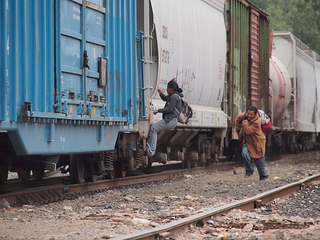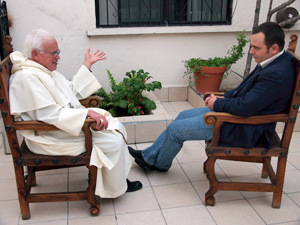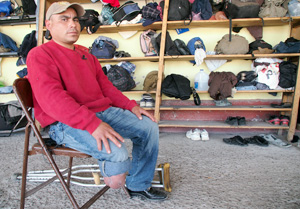
Trains are the main means of transport used by migrants from Central America to cross Mexico and reach the border with the United States. But climbing onto their roofs or perching between two rail cars is a dangerous undertaking. Credits: Worms/Caritas
“It happened on 20 December 2009, in the province of Chiapas. When I fell off the train, my right leg went under the wheels. But I’m lucky. I’m still alive.”
It’s not the first time that Edwin, a migrant from Honduras, has crossed Mexico. His first journey across the country dates back to 2000. He managed to cross the border four times, and each time he was deported by the United States immigration authorities. Today he’s back in the Caritas migrant reception centre in Saltillo. After five months of travelling from Honduras, he’s arrived at his destination.
“I don’t want to go the United States anymore. I’ve come here to try and find an artificial limb. With God’s help, I’m counting on Caritas and the extraordinary people who work in this house to help me to get it.” With his new artificial leg, Edwin will give himself up to the immigration department to be repatriated to Honduras. Then he’ll finally be able to put his migrant past behind him, enjoy time with his family and farm his land in Honduras. “I’m a farmer,” he says. “I’ve always worked the land and raised livestock. Even though it’s difficult to live off farming and stockbreeding in Honduras, from now on I want to fight to be able to do it. I’ll manage to survive together with my family in my own country.”
Trains are the main means of transport used by migrants from Central America to cross Mexico and reach the border with the United States. But climbing onto their roofs or perching between two rail cars is a dangerous undertaking.

It’s not the first time that Edwin has crossed Mexico. His first journey across the country dates back to 2000.
Credit: Worms/Caritas
“Nowadays, migrants crossing Mexico are faced with the worst atrocities,” explains Monsignor Vera, Bishop of Saltillo. “Now there are only freight trains, which are under the close surveillance of private security companies. These companies’ guards were the first to extort money from migrants, pushing them off trains if they refused to bow to their demands. We’ve witnessed this violence. We have to look after people who lose an arm, a leg or their life when they’re thrown onto the tracks. Three migrants have killed by these guards in Saltillo. These actions are designed to spread fear among migrants.”
The trains have also become the theatre of operations for criminal groups who attack migrants. Edwin has seen security conditions for migrants deteriorate in recent years.
“The first time I crossed Mexico and the border there weren’t any problems. Today, travelling on trains has become a permanent struggle against death. Of course, there’s fatigue, hunger and cold. The risk of going to sleep and falling off the train is great. But the criminal gangs who rob, rape and kidnap the men and women on the trains are the worst of all. I had all my things stolen and I was also beaten up.Women have to put up with the most terrible situation. They’re always subjected to the worst violence. That’s why I’ve never let my sisters set out on this journey. I don’t want them to run the risk of experiencing what I’ve seen.”
Monsignor Vera speaks of a humanitarian tragedy. After spending twelve years in the region, he’s convinced that the violence undergone by migrants isn’t inevitable, but rather is used to prevent migration to the United States.
“Violence and cruelty have reached unprecedented levels in this country. The figures are frightening. Between 18,000 and 20,000 migrants are kidnapped each year, and subjected to torture, rape and murder.”

It’s not the first time that Edwin has crossed Mexico. His first journey across the country dates back to 2000.
Credit: Worms/Caritas
“The persecution of Latin American migrants by North American immigration officials is becoming increasingly harsh,” says Edwin. Checks are constant and expulsions are carried out unceremoniously. The last time I was there I really was treated like a criminal.”
For Monsignor Vera, the problem has to be considered as a whole. “Governments should recognise their responsibility regarding the causes of forced migration. For example, the United States and its economic policies are partly responsible for the extreme poverty affecting some Central American countries. Repressing migrants isn’t the solution. On the contrary, governments should give priority to protecting people who decide to migrate and ensure that their human rights are respected. Finally, countries should work together in order to guarantee dignified living conditions for all people. This is the only way we can prevent so many young men and women from risking their lives on these trains of terror.”
